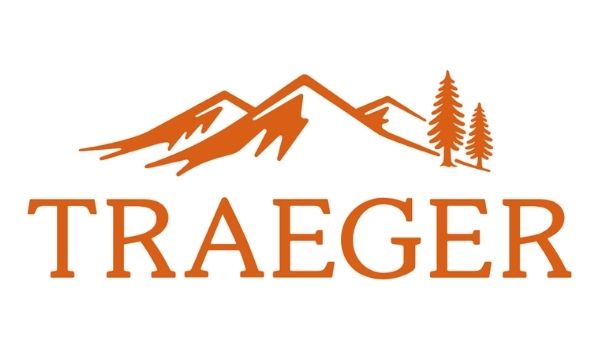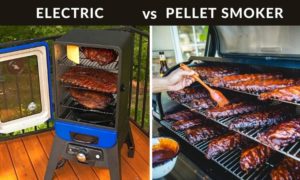If you’re diving into the wonderful, smoke-filled world of pellet grills, you might be wondering if you can mix and match between brands of pellets.
Does the brand of pellet matter at all, or is it all just smoke and mirrors?
Let’s take a close look at two of the most popular brands and compare Pit Boss and Traeger wood pellets to find out.
Pit Boss Smoker Pellets
Pit Boss makes some outstanding and often affordable pellet grills, so it’s no wonder they also make some great wood pellets to fuel them. The company takes the responsibility seriously and provides high-quality pellets made from sustainable sources.
Pit Boss pellets are made in Arkansas, and all of their hardwood comes from North American suppliers. They make a special effort to use wood from storm-damaged or older trees to minimize the environmental impact and improve the health of forests.

The company pays special attention to creating these wood pellets with the end-user in mind.
First, logs are carefully sorted and debarked at the factory before being chipped to reduce ash during burning. Next, the wood is dried and run through a hammer mill to make sawdust, and then they are pressed into pellets without any glues or fillers.
Besides their excellent quality and 100-percent hardwood content, one of the best features of Pit Boss pellets is their consistency.
Available Flavors
Pit Boss sells 14 pellet flavors in 20 or 40-pound bags. For information on which one is the best pair with specific meats, check out the Pit Boss pairing guide found on the side of each bag of pellets.
Here is their full range of pellets available at the Pit Boss online store:
- Apple
- Cherry
- Charcoal
- Classic Blend
- Competition Blend
- Fruitwood Blend
- Hickory
- Maple
- Mesquite
- Oak
- Pecan
- Pitmaster Blend
- Trophy Blend
- Whiskey Barrel
Traeger Smoker Pellets
It could be said that Traeger goes out of their way to sell you on their wood pellets. Their warranty even stipulates that using any other brand will void the warranty.
But, truth be told, there isn’t much difference when you compare Traeger pellets with other high-end, 100-percent hardwood pellets.

All Traeger pellets are milled in the US and get their wood from US sources. While Pit Boss uses one production facility in Arkansas, Traeger uses several mills around the country specializing in particular regional woods.
Their production process is very similar to Pit Boss’s, but they give fewer details about precisely what they do.
For example, they use “clean, green hardwood” and dry it to the optimum moisture content to ensure the production of flavorful blue smoke. Traeger is committed to using sustainable sources, as well. That includes finding hardwood that would otherwise go to waste.
Like Pit Boss, Traeger pellets are consistent and perform flawlessly. And as promised, their pellets produce lots of perfect blue smoke and even heat.
Available Flavors
At the time of writing, Traeger has seven flavors available, plus three limited edition blends:
- Bold Blend — Limited Edition
- Brisket Blend — Limited Edition
- Meat Church Blend — Limited Edition
- Signature Blend
- Turkey Blend
- Apple
- Cherry
- Hickory
- Mesquite
- Pecan
You can order the pellets from Amazon or BBQGuys online store. Note that their selections vary seasonally.
Same as Pit Boss, Traeger also has a pairing guide printed on each pellet bag.
Differences Between Pit Boss and Traeger Pellets
While there is plenty of brand loyalty amongst grill owners out there, when it comes to pellets, there just isn’t much difference between them.
If the pellet is food-grade and made from 100-percent hardwoods with no glues or fillers, then chances are it’s going to work fine.
The differences start popping up when you compare these name brands to low-quality discount grilling pellets — or, worse still, to pellets made for other purposes. For example, wood pellets used for heating fuel will be made with additives and fillers that can quickly gum up a pellet grill and add all sorts of funk to your food.
More often than not, the choice will come down to flavor. Once you get in deep and start loving your pellet grill, you will inevitably start experimenting with different hardwoods to make your own unique pit blend. And in the process, you won’t be shopping for a brand so much as that particular wood species you want to try.
Differences Between Pit Boss and Traeger Pellet Grills
Each model of Traeger and Pit Boss grill has slightly different specs, so to figure out which one is for you, and how they differ from one another, you’ll want to sit down and compare apples to apples.
For a detailed analysis, check our article with a comparison of Traeger and Pit Boss pellet grills.
In general, you will find a similar lineup from both manufacturers. One might have a slightly bigger hopper or slightly more cooking area. Of course, there are differences, but you are getting an outstanding pellet grill that you will likely love in both cases.
There is one feature that sets Pit Boss grills apart, however. Pit Boss incorporates and slide-out plate over the firebox, which acts as a flame broiler. For searing, you can’t beat the crazy-hot fire the Pit Boss gives you!
In addition to excellent pellet grills, Pit Boss also makes some of the best vertical pellet smokers on the market.
Pit Boss Pellets in a Traeger Grill and Vice Versa
The short answer to the question is yes. You can use Pit Boss pellets in a Traeger pellet grill and vice versa. You can also experiment with other brands, like Weber and Camp Chef pellets, in your grill.
Just make sure that they are 100-percent hardwood, food-grade pellets designed for smokers and grills, and you should be golden.
However, there are some rare cases where the hopper of a certain model of a pellet grill is very sensitive and works best with the pellets that are the same brand as the grill. If you use another brand the hopper sometimes gets stuck and stops feeding pellets. This never happened to me but I have some friends who have reported such incidents.
The bottom line is that both Traeger and Pit Boss make some of the best smoking hardwood pellets on the market. Both companies make unique blends and species-specific pellets for every dish you might want to try. Best of all, these options give you the power to experiment and make blends of your own.
In the end, it’s the wood that counts — not the brand.








